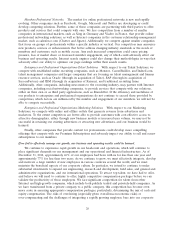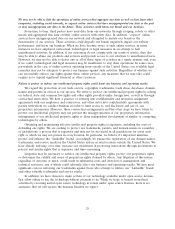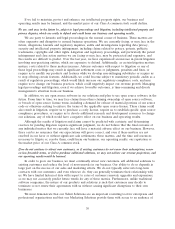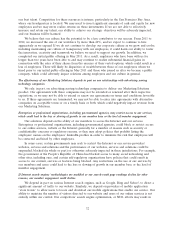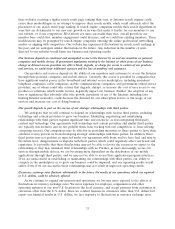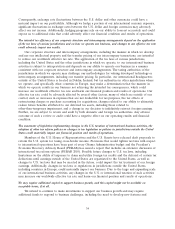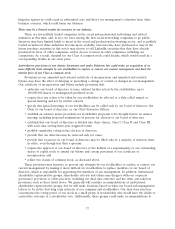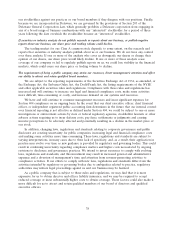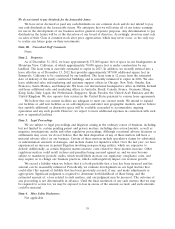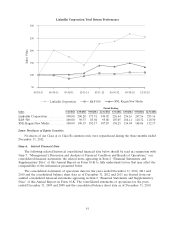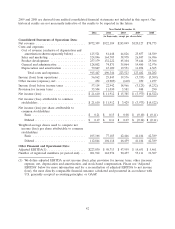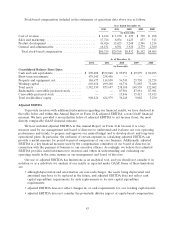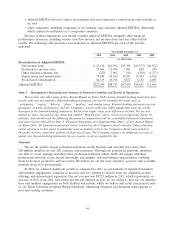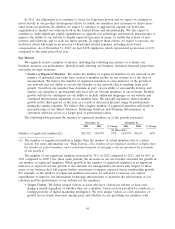LinkedIn 2012 Annual Report Download - page 38
Download and view the complete annual report
Please find page 38 of the 2012 LinkedIn annual report below. You can navigate through the pages in the report by either clicking on the pages listed below, or by using the keyword search tool below to find specific information within the annual report.Risks Related to Our Class A Common Stock
The dual class structure of our common stock as contained in our charter documents has the effect of
concentrating voting control with those stockholders who held our stock prior to our initial public offering,
including our founders and our executive officers, employees and directors and their affiliates, and limiting our
other stockholders’ ability to influence corporate matters.
Our Class B common stock has 10 votes per share, and our Class A common stock has one vote per
share. Stockholders who hold shares of Class B common stock, including our founders, and our executive
officers, employees and directors and their affiliates, together held approximately 69.1% of the voting
power of our outstanding capital stock as of December 31, 2012. Our co-founder and Chair, Reid
Hoffman, controlled approximately 16.3% of our outstanding shares of Class A and Class B common
stock, representing approximately 61.5% of the voting power of our outstanding capital stock as of
December 31, 2012. Therefore, Mr. Hoffman has significant influence over the management and affairs of
the company and over all matters requiring stockholder approval, including election of directors and
significant corporate transactions, such as a merger or other sale of our company or its assets.
Mr. Hoffman will continue to have significant influence over these matters for the foreseeable future.
In addition, the holders of Class B common stock collectively will continue to be able to control all
matters submitted to our stockholders for approval even if their stock holdings represent less than 50% of
the outstanding shares of our common stock. Because of the 10-to-1 voting ratio between our Class B and
Class A common stock, the holders of our Class B common stock collectively will continue to control a
majority of the combined voting power of our common stock even when the shares of Class B common
stock represent as little as 10% of the combined voting power of all outstanding shares of our Class A
and Class B common stock. This concentrated control will limit the ability of our Class A stockholders to
influence corporate matters for the foreseeable future, and, as a result, the market price of our Class A
common stock could be adversely affected.
Future transfers by holders of Class B common stock will generally result in those shares converting
to Class A common stock, which will have the effect, over time, of increasing the relative voting power of
those holders of Class B common stock who retain their shares in the long term. If, for example,
Mr. Hoffman retains a significant portion of his holdings of Class B common stock for an extended period
of time, he could, in the future, control a majority of the combined voting power of our Class A and
Class B common stock. As a board member, Mr. Hoffman owes a fiduciary duty to our stockholders and
must act in good faith in a manner he reasonably believes to be in the best interests of our stockholders.
As a stockholder, even a controlling stockholder, Mr. Hoffman is entitled to vote his shares in his own
interests, which may not always be in the interests of our stockholders generally.
Our stock price has been volatile in the past and may be subject to volatility in the future.
The trading price of our Class A common stock has been volatile historically, and could be subject to
wide fluctuations in response to various factors, some of which are beyond our control. For example,
fluctuations in the valuation of companies perceived by investors to be comparable to us or in valuation
metrics, such as our price to earnings ratio, could impact our stock price. Additionally, the stock markets
have at times experienced extreme price and volume fluctuations that have affected and might in the
future affect the market prices of equity securities of many companies. These fluctuations have, in some
cases, been unrelated or disproportionate to the operating performance of these companies. Further, the
trading prices of publicly traded shares of companies in our industry have been particularly volatile and
may be very volatile in the future. These broad market and industry fluctuations, as well as general
economic, political and market conditions such as recessions, interest rate changes, international currency
fluctuations or political unrest, may negatively impact the market price of our Class A common stock. In
the past, companies that have experienced volatility in the market price of their stock have been subject to
securities class action litigation. We may be the target of this type of litigation in the future. Securities
36


